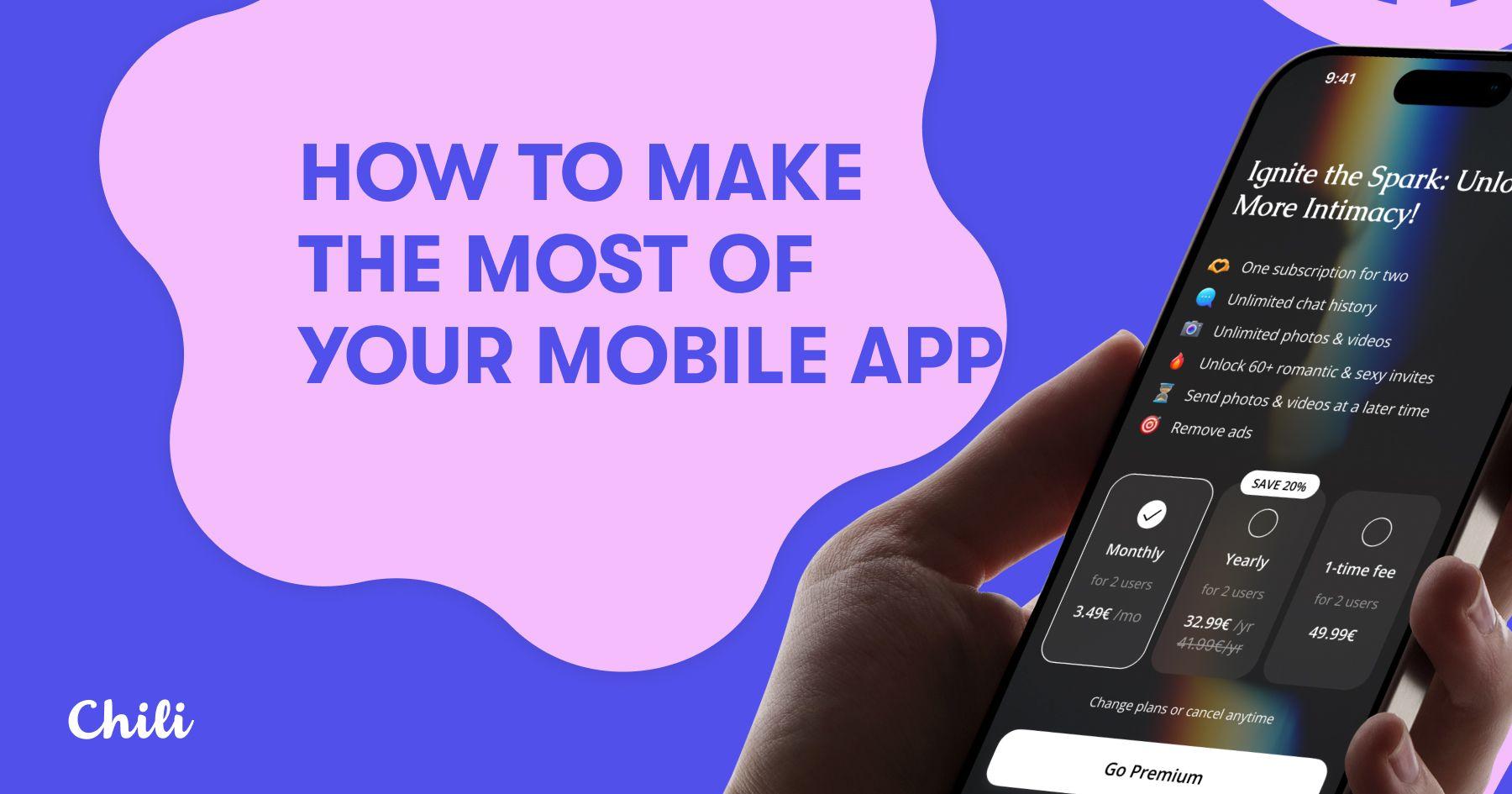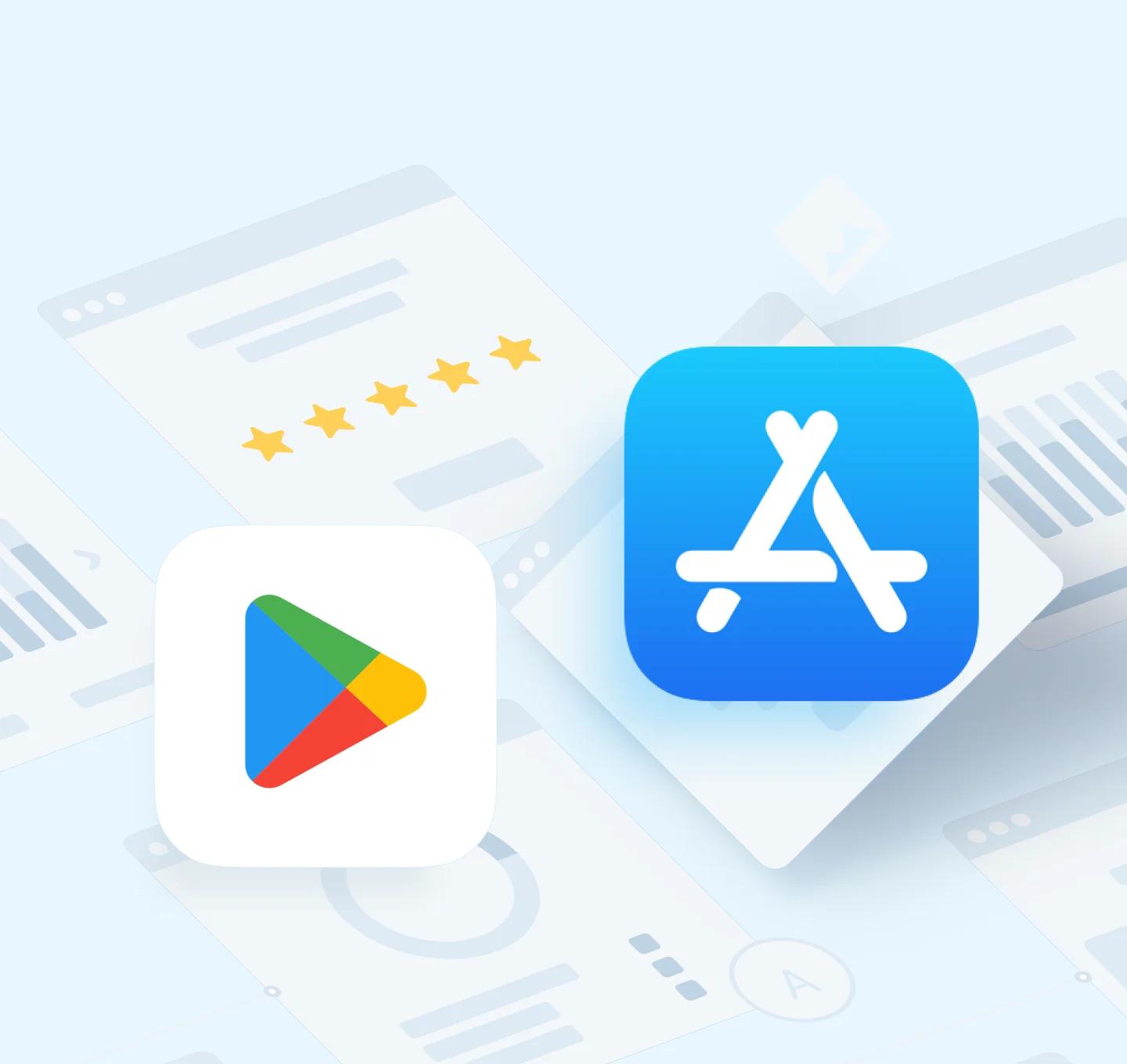How to Make the Most of Your Mobile App: 12 Proven Strategies



How to Make the Most of Your Mobile App: 12 Proven Strategies
Have you though on what actually makes some of the best mobile apps to shine and lead the charts and what makes others to never be noticed?
Developing a mobile app is one thing, but making it noticed and truly successful is another. This is a constant struggle of app developers, marketers and business owners that majority of the time the app itself is not a deciding factor in app success equation. But, what does then?
In order to start, we need to learn whether you’re just starting your app development journey or already have a product on the market. The strategy and steps will be very different, as well as the expenses and possibilities.
Here’s a structured guide with the most important levers you can pull to maximize your app’s potential, so you take can dramatically influence growth, revenue, and retention.
First step - understanding where we are at?

If you want to run a sustainable, scalable app business, there are three metrics you must know:
1. Knowing your audience
Retention, DAU, MAU and your Target audience.
Here we need to know how big your current audience is. In app world we check the main parameters - DAU (Daily Active Users) & MAU (Monthly Active Users), that indicated how much of a users have your app opened daily, or weekly, monthly. How much % of them are “first openers” (aka New users) and what % of them are Returning users. This will help us understand so called Retention rate - how big of % of users come back to your app daily.
We want the app data to show us that new users are returning to app daily, spend their time inside and are doing that consistently. This is a healthy sign that we can invest more to marketing and app promotion.
2. How much each user is worth? Lifetime Value (LTV) - This metric underpins whether your business model even works.
Second, we need to know your lifetime value per user (LTV), if you don't know that yet, it would be really essential to do this now - because this actually is one of the most limiting factors for your app marketing strategy. Definitely need to start with the LTV calculation, here I will show the formulas how to do that, it is simpler than it looks, trust me!
LTV = ARPU x Average Customer Lifespan
How is ARPU calculated? ARPU, or Average Revenue Per User, which means you need to take all of your app - Total Revenue and divide it to / Number of Active Users
ARPU =Total RevenueNumber of Active Users
Once calculated, we will know how much, on average, your user spend (or bring in revenue) during their entire time with your app. It will help us to understand the maximum possible cost of customer acquisition for paid marketing. In traditional business practice you should spend less per user to attract, than you monetise from the user.
3. How much do you spend to be sustainable?
Essential expenses, or your “breakeven” point.
This is simple, here you should count only the things that are essential to “keep the lights on”. Nothing like new features, marketing, something new should not be here.
- Salaries, taxes, benefits, freelancers
- Dev/design licenses, cloud, etc.
- Rent, utilities
- Accounting, legal, insurance, bank fees
We need to know this to know how much actually we need to earn to just be sustainable and how much “excess” revenue we can use to grow the app in stores.

Step 4: Track Conversions
Conversion happens at multiple stages:
-
From App Store impression → install
-
From free user → paid user
-
From trial → subscription
Understanding these funnels shows you where users drop off and where improvements will deliver the biggest gains.
12 Practical Strategies to Maximize Your App
Once you know your LTV, retention, and conversion, you’re ready to optimize. Here are the top 12 ways to get the most out of your app:
1. Invest in App Store Optimization (ASO)
Let's start with “organic” (or free) things first. App Store Optimization (ASO), which is like search engine optimization, but for the apps. What it gives you, a passive listings on App Store and Google Play that will allow users get familiar with your app before the download, by optimizing your title, description, keywords, and visuals helps users find your app organically.
I would recommend investing initially in ASO and SEO (create a simple landing page about your app). I understand that it can be a lot of work, but there are a lot of good services out there, like Framer, Wix, and so on, that will help you to get your website done in no time. For ASO my recommendation list is Apptweak, ASOMobile, also there are so many articles on how to improve your ranking using ASO + SEO.

2. Use Push Notifications
Push notifications (Notifications that are planned and sent by your marketing team) and In-app notifications (notifications that were pre-built in your app by developers) are your best re-engagement tools. Notifications are helping us as a business to remind users to perform some certain actions in the app, remind about our existence and help to get that extra LTV value.
Some useful cases on how to use it right to monetize your user better:
- Useful Reminders and core actions (e.g., unfinished tasks, missed activity), that leads to revenue increase (for example they watch that one more advertisement)
- Promos of functionality, app updates, or new features.
- User did not convert to paying? Send different pricing option or different paywall.
Done right, these drive more opens, which means more revenue, app stickiness and retention.
3. Offer a Free Trial
Before doing this - Important to know your conversions, as some of the apps are perfectly fine without a Trial option, and we need to know that there is a problem. Here are some benchmarks to check:
- From App Store impression → install
AppTweak: average install rate (impression → install) on the US App Store is ~ 3.8 % across categories. AppTweak
- From free user → paid user
Typical range: 1 % – 10 %, though most fall in 2 % – 5 % Userpilot
- From trial → subscription
Many SaaS / subscription apps get 15 %–25 % trial → paid conversion. Adapty
How to do it:
- Keep it short: 3–7 days is usually enough
- Ensure the trial showcases the app’s best features
- Do not overcomplicate things, keep free things free, but those that are your “moneymaker features”, should be locked behind the paywall
- If your app is free, try switching from “freemium vs free trial” as an experiment, the chances are people will be okay to pay subscription.

4. Experiment with Pricing
Not all markets have the same purchasing power. Have you heard of the “Big Mac index”? Same applies here - you cannot charge the same amounts in USA and Turkey, Singapore and Pakistan, the difference in income is huge, as well as value per user (Ad revenue) is very different. Same about your cost of acquisition for the user, it is very different, so check what is your biggest region of users and calculate LTV to the country, what you can afford and what you cannot.
Consider doing:
- Regional pricing adjustments, no need to invent something, do similar to the big players, like Spotify or Netflix with services like - (https://mts.io/projects/spotify-pricing/)
- Temporary discounts or bundles. Black friday, Cyber Monday, etc. Make sure you do not miss the opportunity to give a discounted price to user.
- Testing “freemium” vs. premium-only models. Sometimes loosing “free users” helps the business to grow and earn money. Experiment!
5. Run Email Campaigns
Yeah, Email campaigns! Even in 2025, there is a great place for a good old email campaign, especially with new restrictions from Apple and Google on Push notifications usage, and that they can “mute” the notifications if the app is not used for a prolonged time.
Email gives you another way to reach out to your user. Use it to:
- Remind inactive users. We are alive and we miss you…
- Share new features or content. We changed a lot since you last was in…
- Drive conversions with special offers. Something that is not available in the app…
Important: Make sure you've got a consent from user to receive marketing materials, otherwise the email sender service will stop sending your messages and more emails will get to spam.

6. Enable Guest Mode
If sign-up is a barrier - according to analytics you see that there are many users who opened your app, but never registered.Then consider to allow users to explore your app without registering. Once they see the value, they’ll be more likely to commit to registration, push notifications permission, email and of-course subscription.
7. Short Message Service - SMS
If your product collects SMS messages, this method is for you. It's expensive, but very effective!
SMS permission is hard to get, in terms of data collection, GGPR compliance, but it's one of the most effective ways how to get users' attention. Try not to abuse it because this is very sensitive data and this is one of the few channels people have without that much of spam coming to them.
Use with caution, as SMS is powerful but sensitive:
- Great for urgent updates, security alerts, or time-limited offers (there must be a value, not your basic 10% off)
- Overuse risks alienating users
8. Add Remote-Controlled In-App Banners
Remote config, or remote controlled features - is basically a script that is executed before the app displays content to user, and it can contain different rules, to display custom thing for exact users (like a banner for users who are from USA, and did not engage with your key functionality, or a feedback form for every 5th user to gather what are they missing in the app).
And In-app banner - these dynamic banners let you run promotions, upsells, or announcements without shipping a new version. They’re especially useful for non-converting users. Also, you can gather feedback from users, adding a custom CTA buttons to the app without a release, and with a possibility to quickly remove it, if things go south.
9. Run A/B Tests
Test everything! Store listings, icons, pricing, purchase flows. But be patient:
-
Wait at least 2–3 weeks to see reliable trends.
-
Don’t make decisions on small, volatile samples.
With A/B tests, you can test a lot of stuff, but the basic ones, that you can configure out yourself -
- Listings on the stores (screenshots, video, texts)
- App Icons
- Product pages
A bit more difficult level would be to test
- Purchases and prices
- Paywalls
- Onboarding User Experience (UX)
Do not make rush decisions, please be patient, as it only works on big numbers. Google recommends 30,000 users affected, and 3,000 conversions at least. In my opinion, that's a bit too much, especially on the smaller scale apps. So, wait for three weeks, a month if you don't have huge audience. And if you “hit the right change” you will see it changing in your revenue, trials and other conversions. However, if the trend is volatile, goes up, goes down, then most probably you don't have to touch anything and it will even out.

10. Localize Your App
Localization opens doors to entirely new markets. Start with your app store listings, then expand to in-app content and support.
This is one of the easiest things to do - Localization opens doors to entirely new markets. You can add a lot of new users and make your app more accessible to everyone.
- Greatly improves app Stickiness and opens new audience.
On a downside, localizations require much more commitment for the support of the app. All new updates will require to have the localised functions, files, etc. But with modern technology, AI and translation possibilities, this is much simpler and easier task to complete.
11. Improve Analytics and Iterate
Cover everything with Analytics, see where users click, where they drop off, and what features drive engagement. Without analytics, you’re blind. With it enabled, you can make informed improvements.

Where to start? - https://chililabs.io/blog/how-to-do-marketing-in-mobile-apps
Check for the initial events:
- App Openings
- Retention
- Core functionality events
- Registration successful
Good rule, is to track as much as possible before making radical changes in the app (if there is something to loose), if not - break things and you will notice is you hit something that works.
12. Paid channels
- Google Ads
- Meta Ads
- TikTok
- …
There are so many paid channels to experiment with, as well as so many nuances and tricks. Will not speak much of it here, as there are a lot of things to cover and probably I'm not skilled enough to teach you things.
This is probably the most effective way to gain traffic to your apps, but the most important is to remember about your LTV target and not to forget to monetize your apps. In ideal world, you should spend on attracting a user through ads less than an average person gives you in revenue.
Couple of rules that works for me:
- ROAS campaigns - Return on Ad Spend, this is basically Google or facebook promise that they know their audience and will show your ads (very expensively), but that it will return the investment according to your ROAS set target (like 110% of the amount spent).
- Iterate creatives, mix AI generated, do not overcomplicate and no need to make production quality videos. Sometimes the worst ads by design perform the best 🤷
- Create one campaign per country, do not mix audiences, later on it is harder to work with
Final Thoughts
In a digital world, that we currently have there are plenty of things, hacks, ideas and tools that can help your app grow. In this article I've shared only the items that I have personally tried and that worked for our apps here at Chili Labs. Unfortunately, there’s no silver bullet for app success. But by combining data-driven insights (LTV, retention, conversion) with smart growth tactics (ASO, notifications, pricing, trials, localization), you can systematically improve your app’s performance.
Small, consistent changes compound into long-term growth. Start with the basics, measure relentlessly, and keep iterating! Good luck, and feel free to share your findings, ideas and impressions with me.

Similar articles
Discover more with our related articles section. Stay informed about mobile app development, event organizing, and more.
How to understand if your business needs a mobile application?
After speaking with hundreds of founders, managers and business owners on why they should, or should not invest money into...
How to do marketing in mobile apps
Analysing your app, is similar to visiting a doctor! To fix something, you need to know something. This is why...

